Return of the Jedi: Death Star Battle
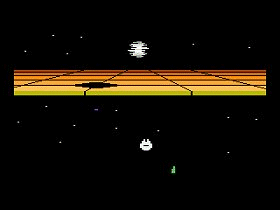 The Game: Presumably, you play the part of Lando Calrissian in this game, which seems to follow the events in the latter half of the film Return of the Jedi. Piloting the Millennium Falcon, you dart around the perimeter defense shield of the Empire’s new Death Star, which is still being constructed before your very eyes. You must eliminate a certain number of TIE Interceptors before a hole opens in the shield, allowing you to get close enough to start blowing pieces out of the Death Star itself. But an automatic defense system won’t take long to track you down and eliminate you, so you have to work fast. The sooner you can hit the Death Star power core, the better. And when you accomplish that, you have to worry about dodging the flaming debris of the huge space station… (Parker Brothers, 1983)
The Game: Presumably, you play the part of Lando Calrissian in this game, which seems to follow the events in the latter half of the film Return of the Jedi. Piloting the Millennium Falcon, you dart around the perimeter defense shield of the Empire’s new Death Star, which is still being constructed before your very eyes. You must eliminate a certain number of TIE Interceptors before a hole opens in the shield, allowing you to get close enough to start blowing pieces out of the Death Star itself. But an automatic defense system won’t take long to track you down and eliminate you, so you have to work fast. The sooner you can hit the Death Star power core, the better. And when you accomplish that, you have to worry about dodging the flaming debris of the huge space station… (Parker Brothers, 1983)
 Memories: Possibly the best game Parker Brothers released out of its series of four Star Wars titles, Death Star Battle had some truly great graphics considering which machine they were squeezed out of. The vaguely 3-D grid of the Death Star’s defense perimeter would constantly shift colors, and it was actually very pretty. The game play itself was no slouch either – one out of five times is about how often I manage to evade all the Death Star debris without getting creamed.
Memories: Possibly the best game Parker Brothers released out of its series of four Star Wars titles, Death Star Battle had some truly great graphics considering which machine they were squeezed out of. The vaguely 3-D grid of the Death Star’s defense perimeter would constantly shift colors, and it was actually very pretty. The game play itself was no slouch either – one out of five times is about how often I manage to evade all the Death Star debris without getting creamed.
RealSports Baseball
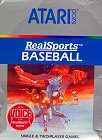 The Game: Batter up! Take charge of a team on the baseball diamond for a practice round, or a game lasting 3, 6 or 9 innings. And if you think being behind a joystick will save you from hearing from the umpire, think again. (Atari, 1983)
The Game: Batter up! Take charge of a team on the baseball diamond for a practice round, or a game lasting 3, 6 or 9 innings. And if you think being behind a joystick will save you from hearing from the umpire, think again. (Atari, 1983)
Memories: In 1979, the mainstay of home video gaming was space, not sports. That’s hard to imagine these days, when you have giants like Electronic Arts dropping the equivalent of some small countries’ gross national debt to lock down entire professional sports leagues. Sure, there was sports games in 1979, but they were at such a primitive level that they just weren’t a match for Space Invaders and Asteroids; the most realistic sports simulations still lived in the arcade. In 1980, Intellivision changed the playing field, literally and figuratively, as Mattel introduced sports games that actually bore some resemblance to their inspiration. A surprisingly aggressive marketing campaign for a relative newcomer to the video game field put Atari on notice: take sports games seriously.
Seaquest
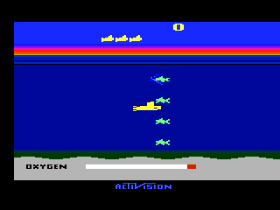
 The Game: You’re commanding a submarine roaming the depths of the Atari 2600, attempting to rescue divers while also battling off sharks and enemy subs. Once you’ve gotten six of those defenseless divers aboard, you’ll need to surface to offload them. If either the sharks or subs collide with you, you lose a sub and one diver (I haven’t quite figured out how the rest of the divers manage to survive the collision, but then again they are wearing scuba gear…but still, how do they wind up aboard the next sub?) – and you’re equally dead if your oxygen meter runs empty, but you can prevent that by surfacing and replenishing it before returning to the deep. (Activision, 1983)
The Game: You’re commanding a submarine roaming the depths of the Atari 2600, attempting to rescue divers while also battling off sharks and enemy subs. Once you’ve gotten six of those defenseless divers aboard, you’ll need to surface to offload them. If either the sharks or subs collide with you, you lose a sub and one diver (I haven’t quite figured out how the rest of the divers manage to survive the collision, but then again they are wearing scuba gear…but still, how do they wind up aboard the next sub?) – and you’re equally dead if your oxygen meter runs empty, but you can prevent that by surfacing and replenishing it before returning to the deep. (Activision, 1983)
Memories: This nifty little gem from Activision is one of those games which is incredibly easy to pick up, and hard to put down once you get the hang of it. And the ease of the first few levels is deceptive – this game hustles you big time by softening you up before it starts to throw rows of sharks or subs at you.
Q*Bert
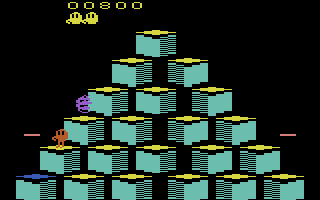 The Game: Q*Bert, a nosey little guy with a propensity for hopping, spends his time hopping around a three-dimensional pyramid of cubes, avoiding Coily the Snake and other assorted purple and red creatures, including a few who operate on a slightly different plane (i.e., they move down the pyramid as if it were rotated one-third). Any green objects and creatures Q*Bert can catch will not hurt him – in fact, the little bouncing green balls will stop time briefly for everyone but Q*Bert. If he gets into a tight spot, Q*Bert can jump off the pyramid onto a flying disc which will deposit him back at the top of the pyramid – and lure Coily to a nasty fate by jumping into nothing. Changing the colors of the top of every cube in the pyramid to the target color indicated at the top left of the screen will clear the pyramid and start the craziness all over again. If Q*Bert is hit by an enemy or falls off the pyramid, he hits bottom with a burst of incomprehensible obscenity! (Parker Brothers, 1983)
The Game: Q*Bert, a nosey little guy with a propensity for hopping, spends his time hopping around a three-dimensional pyramid of cubes, avoiding Coily the Snake and other assorted purple and red creatures, including a few who operate on a slightly different plane (i.e., they move down the pyramid as if it were rotated one-third). Any green objects and creatures Q*Bert can catch will not hurt him – in fact, the little bouncing green balls will stop time briefly for everyone but Q*Bert. If he gets into a tight spot, Q*Bert can jump off the pyramid onto a flying disc which will deposit him back at the top of the pyramid – and lure Coily to a nasty fate by jumping into nothing. Changing the colors of the top of every cube in the pyramid to the target color indicated at the top left of the screen will clear the pyramid and start the craziness all over again. If Q*Bert is hit by an enemy or falls off the pyramid, he hits bottom with a burst of incomprehensible obscenity! (Parker Brothers, 1983)
Memories: This game has been much-maligned by some VCS owners over the years, which is something I take issue with. The 2600 translation of the famous arcade game was just fine! The graphics conveyed the pyramid of cubes just fine, it was easy to tell which way Q*Bert was headed, and overall I had no complaints. Even the sound effects, even though they were in some cases not even close to the distinctive sounds of the original, had their own strange charm.
Q*Bert
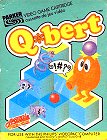 The Game: Q*Bert, a nosey little guy with a propensity for hopping, spends his time hopping around a pyramid of colorful blocks, avoiding Coily the Snake and other assorted purple and red creatures, including a few who operate on a slightly different plane (i.e., they move down the pyramid as if it were rotated one-third). Any green objects and creatures Q*Bert can catch will not hurt him – in fact, the little bouncing green balls will stop time briefly for everyone but Q*Bert. If he gets into a tight spot, Q*Bert can jump off the pyramid onto a flying disc which will deposit him back at the top of the pyramid – and lure Coily to a nasty fate by jumping into nothing. Changing the colors of the top of every block in the pyramid to the target color indicated at the top left of the screen will clear the pyramid and start the craziness all over again. (Parker Brothers, 1983)
The Game: Q*Bert, a nosey little guy with a propensity for hopping, spends his time hopping around a pyramid of colorful blocks, avoiding Coily the Snake and other assorted purple and red creatures, including a few who operate on a slightly different plane (i.e., they move down the pyramid as if it were rotated one-third). Any green objects and creatures Q*Bert can catch will not hurt him – in fact, the little bouncing green balls will stop time briefly for everyone but Q*Bert. If he gets into a tight spot, Q*Bert can jump off the pyramid onto a flying disc which will deposit him back at the top of the pyramid – and lure Coily to a nasty fate by jumping into nothing. Changing the colors of the top of every block in the pyramid to the target color indicated at the top left of the screen will clear the pyramid and start the craziness all over again. (Parker Brothers, 1983)
Memories: One of the last games ever produced for the Odyssey 2, this great adaptation of Q*Bert also has the distinction of being among the hardest to find. Released primarily in Europe for the Videopac (the Dutch-produced equivalent of the Odyssey2), Q*Bert has decent graphics and damned fast gameplay for an Odyssey game.
Pole Position
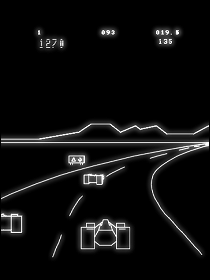 The Game: Prepare to qualify! Fly to the finish line in a fierce field of Formula One competitors in a qualifying lap. Leaving the track is trouble – and hitting one of the billboards dotted around the edges of the Mt. Fuji track is a sure way to miss out on the subsequent race. (GCE, 1983)
The Game: Prepare to qualify! Fly to the finish line in a fierce field of Formula One competitors in a qualifying lap. Leaving the track is trouble – and hitting one of the billboards dotted around the edges of the Mt. Fuji track is a sure way to miss out on the subsequent race. (GCE, 1983)
Memories: When GCE (and, briefly, the eager-to-get-into-the-video-game-business Milton Bradley) debuted the Vectrex, any argument that there was another system better-suited for home ports of arcade vector graphics games was over, period. With willing licensing partners like Cinematronics, Vectrex was a shoo-in. There’s only one problem: by 1983, vector graphics were rapidly falling out of wide use as more advanced raster graphics technology, driven by faster processors, came into play. What games would Vectrex play then?
Popeye
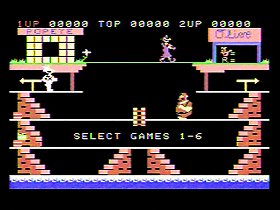 The Game: Well, blow me down! Popeye the sailor man gets his own video game. On level one, you’re trying to catch Olive Oyl’s falling hearts before they descend to sea level and are lost, while ducking Bluto’s punches at the same time. A can of spinach appears every so often, giving you the opportunity to read the big bully the riot act (comic strip-style, of course). On level two, the falling hearts are replaced by falling musical notes, and you’ll need Wimpy’s hefty help to keep Swee’Pea from drifting away on a balloon. (Parker Brothers, 1983)
The Game: Well, blow me down! Popeye the sailor man gets his own video game. On level one, you’re trying to catch Olive Oyl’s falling hearts before they descend to sea level and are lost, while ducking Bluto’s punches at the same time. A can of spinach appears every so often, giving you the opportunity to read the big bully the riot act (comic strip-style, of course). On level two, the falling hearts are replaced by falling musical notes, and you’ll need Wimpy’s hefty help to keep Swee’Pea from drifting away on a balloon. (Parker Brothers, 1983)
Memories: Possibly the most faithful home version of Nintendo’s game about a certain sailor man there is, Popeye for the ColecoVision does this game proud.
Pole Position
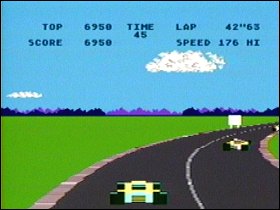 The Game: Prepare to qualify! Fly to the finish line in a fierce field of Formula One competitors in a qualifying lap. Leaving the track is trouble – and hitting one of the billboards dotted around the edges of the Mt. Fuji track is a sure way to miss out on the subsequent race. (Atari, 1983)
The Game: Prepare to qualify! Fly to the finish line in a fierce field of Formula One competitors in a qualifying lap. Leaving the track is trouble – and hitting one of the billboards dotted around the edges of the Mt. Fuji track is a sure way to miss out on the subsequent race. (Atari, 1983)
Memories: When Atari announced its home versions of Pole Position, its first-person racer licensed from Namco, there was rejoicing (for the 5200 version) and scoffing (for the 2600 version). As it turns out, both expectations may have been off the mark: the 2600 version was unexpectedly good for what it was, and by comparison the 5200 version seems at times as though it’s not all it could have been. Maybe the biggest surprise is that these two interpretations of the game weren’t wildly different.
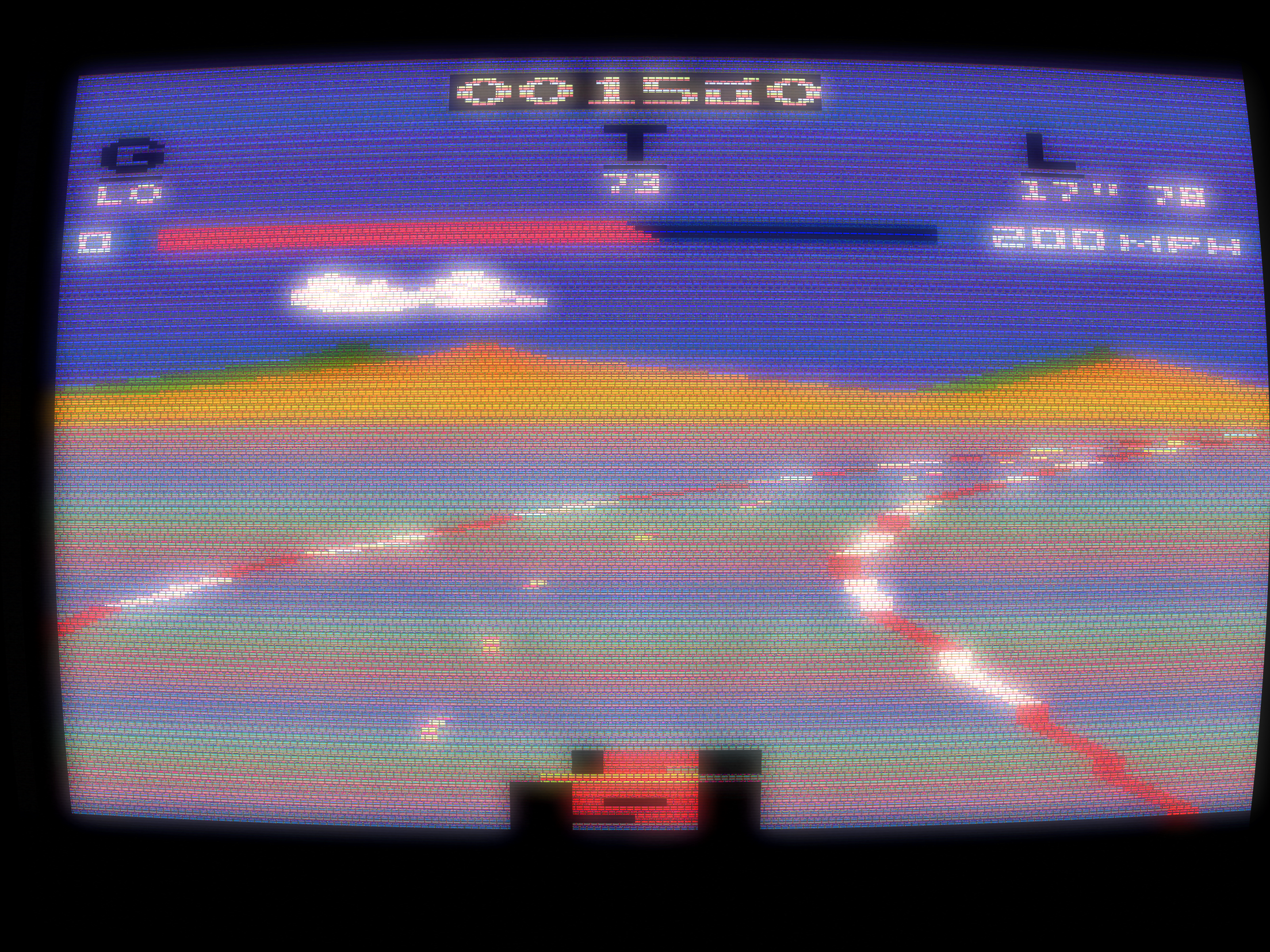
Pole Position
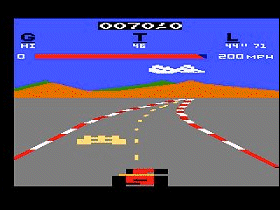 The Game: It’s your big chance to qualify for an unspecified big race at a track near Mt. Fuji in Japan. First, you try to get through the qualifying heat, racking up laps around the track as fast you can and accumulating as few wrecks as possible. If you pass muster, then you get to try it again with other cars on the track! (Atari, 1983)
The Game: It’s your big chance to qualify for an unspecified big race at a track near Mt. Fuji in Japan. First, you try to get through the qualifying heat, racking up laps around the track as fast you can and accumulating as few wrecks as possible. If you pass muster, then you get to try it again with other cars on the track! (Atari, 1983)
Memories: A reasonably faithful version of the then-megahit arcade game, this home port was actually very good considering the 2600’s graphics limitations. But it shared the arcade game’s repetitious nature, which made it a short-lived game which quickly depleted the novelty associated with its name.
Popeye
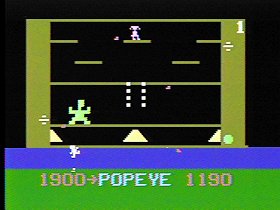 The Game: Well, blow me down! Popeye the sailor man gets his own video game. As Popeye, you’re trying to catch Olive Oyl’s falling hearts before they descend to sea level and are lost, while ducking Bluto’s punches at the same time. A can of spinach appears every so often, giving you the opportunity to read the big bully the riot act (comic strip-style, of course). (Parker Brothers, 1983)
The Game: Well, blow me down! Popeye the sailor man gets his own video game. As Popeye, you’re trying to catch Olive Oyl’s falling hearts before they descend to sea level and are lost, while ducking Bluto’s punches at the same time. A can of spinach appears every so often, giving you the opportunity to read the big bully the riot act (comic strip-style, of course). (Parker Brothers, 1983)
Memories: Well, shiver me timbers! It took me just shy of twenty years to get it, mateys, but this old landlubber has finally gotten his mitts on Popeye for the Odyssey2 – and blow me down, it’s seaworthy!
No Escape!
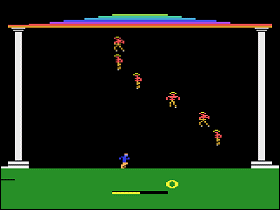 The Game: Jason, having made off with the Golden Fleece, has enraged the gods, who trap him in a temple along with a never-ending supply of Furies. Players can move Jason from side to side to avoid the Furies’ fire, and to fire back – but shooting a Fury directly will create another Fury rather than destroying it. Carefully-timed shots at the temple’s roof, however, will dislodge bricks that can permanently eliminate any Furies that they hit. Jason (and, presumably, countless screaming Argonauts) will advance a level when all of the Furies on the present level are destroyed. Taking too much damage from the Furies (or from chunks of the roof that he himself has caused to fall) will cost Jason his life. (Imagic, 1983)
The Game: Jason, having made off with the Golden Fleece, has enraged the gods, who trap him in a temple along with a never-ending supply of Furies. Players can move Jason from side to side to avoid the Furies’ fire, and to fire back – but shooting a Fury directly will create another Fury rather than destroying it. Carefully-timed shots at the temple’s roof, however, will dislodge bricks that can permanently eliminate any Furies that they hit. Jason (and, presumably, countless screaming Argonauts) will advance a level when all of the Furies on the present level are destroyed. Taking too much damage from the Furies (or from chunks of the roof that he himself has caused to fall) will cost Jason his life. (Imagic, 1983)
Memories: One of the lesser-known Imagic titles for the 2600, No Escape! was titled Escape From Argos for much of its development cycle. It combines the tried-and-true elements of slide-and-shoot games and brick-busting games such as Breakout, but does it in such a novel way that it manages to be fresh.
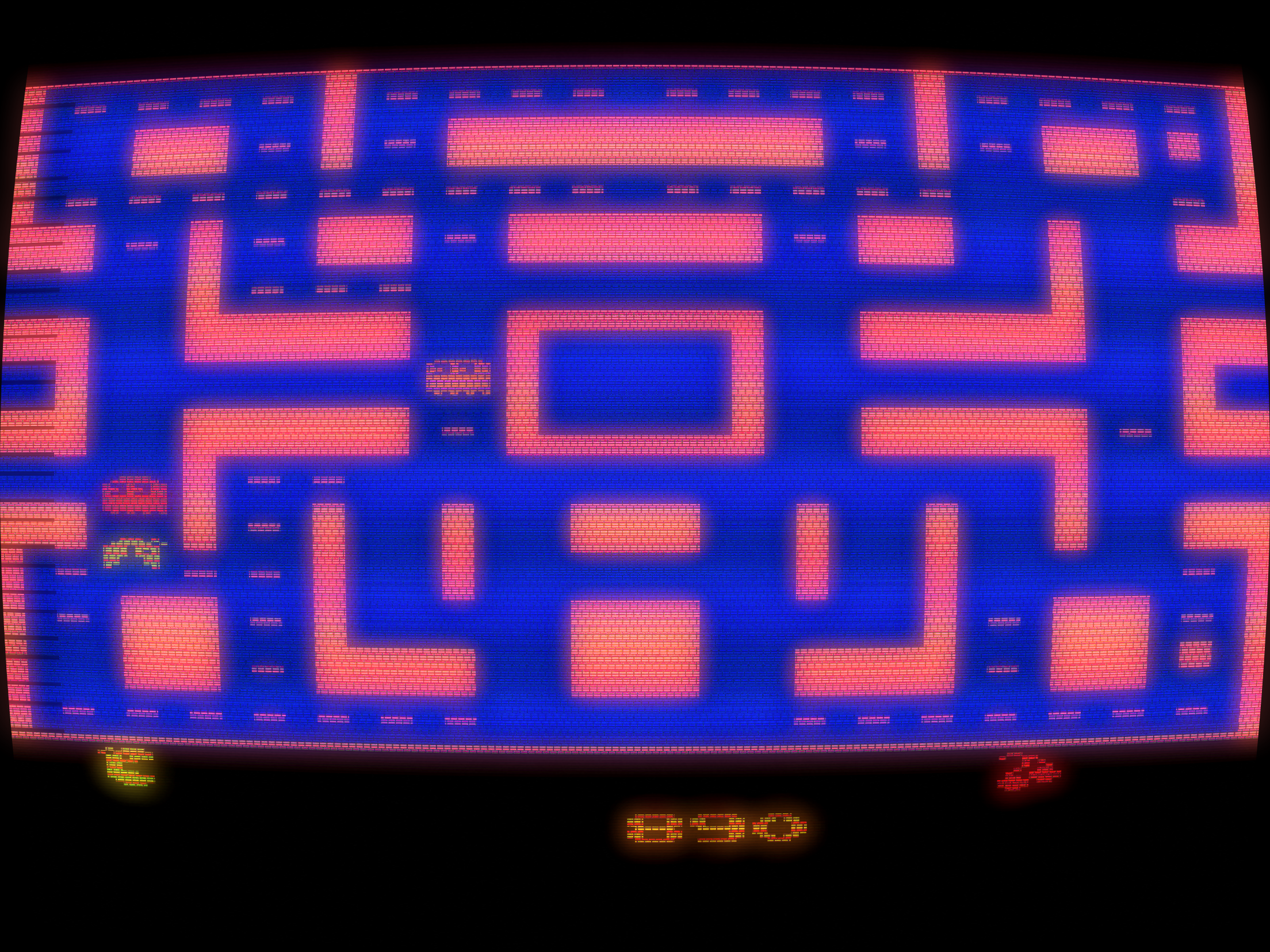
Ms. Pac-Man
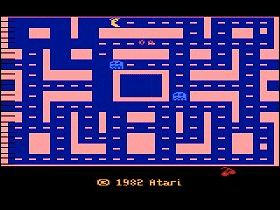 The Game: As the bride of that most famous of single-celled omniphage life forms, your job is pretty simple – eat all the dots, gulp the large blinking dots in each corner of the screen and eat the monsters while they’re blue, and avoid
The Game: As the bride of that most famous of single-celled omniphage life forms, your job is pretty simple – eat all the dots, gulp the large blinking dots in each corner of the screen and eat the monsters while they’re blue, and avoid  the monsters the rest of the time. Occasionally various fruits and other foods will bounce through the maze, and you can gobble those for extra points. (Atari, 1983)
the monsters the rest of the time. Occasionally various fruits and other foods will bounce through the maze, and you can gobble those for extra points. (Atari, 1983)
Memories: Some people were surprised when, after the stunning success of the Ms. Pac-Man arcade game, Atari announced that it would be bringing the latest member of the Pac-family home. After how the first game had turned out, why bother?
Moonsweeper
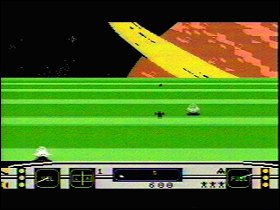 The Game: As the pilot of a super-fast intergalactic rescue ship (which is also armed to the teeth, which explains the absence of a red cross painted on the hull), you must navigate your way through hazardous comets and space debris, entering low orbit around various planets from which you must rescue a certain number of stranded civilians. But there’s a reason you’re armed – some alien thugs mean to keep those people stranded, and will do their best to blast you into dust. You can return the favor, and after you rescue the needed quota of people from the surface, you must align your ship with a series of launch rings to reach orbit again. (Imagic, 1983)
The Game: As the pilot of a super-fast intergalactic rescue ship (which is also armed to the teeth, which explains the absence of a red cross painted on the hull), you must navigate your way through hazardous comets and space debris, entering low orbit around various planets from which you must rescue a certain number of stranded civilians. But there’s a reason you’re armed – some alien thugs mean to keep those people stranded, and will do their best to blast you into dust. You can return the favor, and after you rescue the needed quota of people from the surface, you must align your ship with a series of launch rings to reach orbit again. (Imagic, 1983)
Memories: Not terribly different from the Atari 2600 edition of the same game, Colecovision Moonsweeper gets a big graphical boost from the step up to the most powerful console of the early 80s.
Moon Patrol
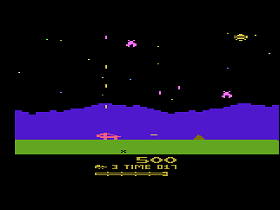 The Game: Driving an agile, armed moon buggy across the lunar surface, you must jump over craters and land mines, shoot large boulders (some occasionally mobile) out of your way, and try not to be on the receiving end of hostile fire from alien ships that try to strafe you. Some of the ships, which look very suspiciously like the triangle-of-spheres enemy ships from Gyruss, can even bomb the moon and make new craters for you to jump over – which may put you right into their line of fire.
The Game: Driving an agile, armed moon buggy across the lunar surface, you must jump over craters and land mines, shoot large boulders (some occasionally mobile) out of your way, and try not to be on the receiving end of hostile fire from alien ships that try to strafe you. Some of the ships, which look very suspiciously like the triangle-of-spheres enemy ships from Gyruss, can even bomb the moon and make new craters for you to jump over – which may put you right into their line of fire.
Later on, you also get to blast away tanks and dodge pesky jet cars which “tailgate” and then try to ram you. (Atari, 1983)
Memories: This was a game that I played the hell out of as a kid – I’m stunned that all the bits didn’t fall out of the cartridge from repeated use. Granted, Moon Patrol in the arcade was a feast for the eyes and ears, and it’d be foolish to expect none of that to be lost in the translation to a far simpler hardware platform like the Atari 2600. But what’s surprising is how much of the game actually survived the transition.

Mario Bros.
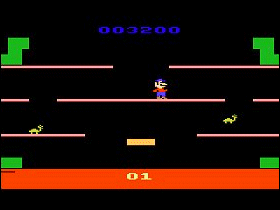 The Game: As Mario (or Luigi, if you’re playing with a second person), you’re trying to rid the sewers of such pests as evil lobsters and turtles. Try to grab as many coins as you can (it’s amazing what people let fall down the drain and into the sewer system sometimes), and always be on the lookout for the fireballs which bounce from level to level. Just how did all these things get into the sewers, anyway? (Atari, 1983)
The Game: As Mario (or Luigi, if you’re playing with a second person), you’re trying to rid the sewers of such pests as evil lobsters and turtles. Try to grab as many coins as you can (it’s amazing what people let fall down the drain and into the sewer system sometimes), and always be on the lookout for the fireballs which bounce from level to level. Just how did all these things get into the sewers, anyway? (Atari, 1983)
Memories: Atari snatched the home video game license for Mario Bros. and proved that it could successfully port the game to the Atari 2600, as if to thumb its nose at Coleco for the mediocre (and that’s being charitable) 2600 version of Donkey Kong Jr.. Mario Bros. turned out to be one of the better Atari arcade adaptations.
M*A*S*H
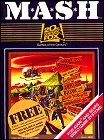 The Game: In a bizarre collision of two very different game play elements that would probably be considered minigames today, you’re a fearless helicopter rescue pilot for the 4077th, fishing wounded U.S. soldiers out of harm’s way during the Korean War. When the window of your helicopter no longer shows up as hollow, you’ve got a full load and must safety return the wounded to the M*A*S*H base, and then go to retrieve more wounded. An enemy tank scoots along the bottom of the screen, trying to down both your helicopter and a computer-controlled chopper or an opponent’s chopper. This does not help matters, although being shot down merely causes a delay as an emergency vehicle appears – miraculously impervious to enemy fire – to push the wreckage off the screen before a new helicopter appears. Every so often, the action suddenly switches to the operating table, where you have to retrieve projectiles from victims’ bodies without causing worse damage as you remove them, and with the clock ticking down – if you fail to complete the surgery in time, then it’s goodbye, farewell and amen to that patient. (Think of the board game Operation! here and you’ve got the idea.) (20th Century Fox Games Of The Century, 1983)
The Game: In a bizarre collision of two very different game play elements that would probably be considered minigames today, you’re a fearless helicopter rescue pilot for the 4077th, fishing wounded U.S. soldiers out of harm’s way during the Korean War. When the window of your helicopter no longer shows up as hollow, you’ve got a full load and must safety return the wounded to the M*A*S*H base, and then go to retrieve more wounded. An enemy tank scoots along the bottom of the screen, trying to down both your helicopter and a computer-controlled chopper or an opponent’s chopper. This does not help matters, although being shot down merely causes a delay as an emergency vehicle appears – miraculously impervious to enemy fire – to push the wreckage off the screen before a new helicopter appears. Every so often, the action suddenly switches to the operating table, where you have to retrieve projectiles from victims’ bodies without causing worse damage as you remove them, and with the clock ticking down – if you fail to complete the surgery in time, then it’s goodbye, farewell and amen to that patient. (Think of the board game Operation! here and you’ve got the idea.) (20th Century Fox Games Of The Century, 1983)
Memories: M*A*S*H could be held up as a prime example of the third party video game market right before the Crash, being two very simple (and not terribly original) games squashed together with a licensed title. But let’s give it credit for being better than, say, Chase The Chuckwagon – M*A*S*H is at least fun.
Kangaroo
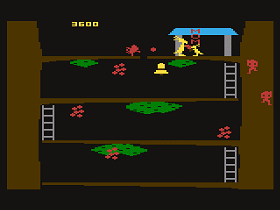 The Game: As a mama marsupial trying to save your baby from many malignant marauding monkeys, you go on a rescue mission that involves climbing through many, many levels of the monkeys’ treehouse village, punching primates, dodging airborne apples, grabbing various fruit items along the way (considering the abundance See the videoof apples, strawberries, cherries and bananas, one can only assume these are Pac-Man’s table leavings), and avoiding the big, purple boxing-glove-stealing ape. (Atari, 1983)
The Game: As a mama marsupial trying to save your baby from many malignant marauding monkeys, you go on a rescue mission that involves climbing through many, many levels of the monkeys’ treehouse village, punching primates, dodging airborne apples, grabbing various fruit items along the way (considering the abundance See the videoof apples, strawberries, cherries and bananas, one can only assume these are Pac-Man’s table leavings), and avoiding the big, purple boxing-glove-stealing ape. (Atari, 1983)
Memories: Released for the Atari 2600 and 5200 simultaneously, it’s a no-brainer as to which version of Kangaroo is a better representation of the sleeper hit game Atari distributed in the U.S. (a rare licensed import for a company that usually released only homegrown product). The 5200 edition looks and plays more like the coin-op, including all four of the original game’s levels and doing so without the strange blue-going-on-purple background of the 2600 cartridge.
Jungle Hunt
 The Game: You are an intrepid, pith-helmeted explorer of the jungle! Swinging from vine to vine! Swimming through crocodile-infested waters! Jumping and ducking huge rolling boulders! And vanquishing spear-weilding natives to rescue the damsel! (Atarisoft, 1983)
The Game: You are an intrepid, pith-helmeted explorer of the jungle! Swinging from vine to vine! Swimming through crocodile-infested waters! Jumping and ducking huge rolling boulders! And vanquishing spear-weilding natives to rescue the damsel! (Atarisoft, 1983)
Memories: One of a handful of Atarisoft games for the ColecoVision, Jungle Hunt proves a point: while Coleco was trying to drive discriminating gamers toward its own console with subpar ports of games like Zaxxon (compare the ColecoVision edition to the Atari 2600 port) and Donkey Kong (again, compare the ColecoVision and 2600 versions), Atari – post-2600 Pac-Man debacle – was at least trying to turn out quality games for whatever platform it released games on.
Joust
 The Game: As a fearless pile of buzzard bait encased in armor, you pilot your trusty steed – who happens to be an ostrich, by the way – in an effort to impale your opponents – who also happen to be riding ostriches – before they can lance you. Other dangers include a pterodactyl who periodically arrives to thin out the ranks of on-screen warriors if things are taking too long, and platforms that disappear under your feet, plunging you into a sea of molten lava. (Atari, 1983)
The Game: As a fearless pile of buzzard bait encased in armor, you pilot your trusty steed – who happens to be an ostrich, by the way – in an effort to impale your opponents – who also happen to be riding ostriches – before they can lance you. Other dangers include a pterodactyl who periodically arrives to thin out the ranks of on-screen warriors if things are taking too long, and platforms that disappear under your feet, plunging you into a sea of molten lava. (Atari, 1983)
Memories: Joust is an incredibly fun and addictive game with a loyal cult following, and Atari did it “joust-ice”. Many of Atari’s home versions of arcade games from this period, whether programmed in-house or farmed out to General Computer, seemed to follow a tenet of getting key graphics and gameplay right above all else, and Joust is a good specimen of that.
Masters Of The Universe: Power Of He-Man
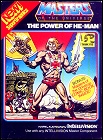 The Game: Don’t be too eager to say “By the power of Greyskull,” because there’s one problem: Skeletor has wrested the power of Castle Greyskull for himself, and seems none too keen on giving it back. As He-Man, the player is tasked with reaching the castle via a flying vehicle, shooting down fireballs (and, if possible, ensnaring Skeleton in traps from above) along the way; provided He-Man doesn’t use up all of his fuel in the aerial fight, he lands at Greyskull and must dodge Skeletor’s fiery projectiles in order to do battle with the ghastly one. Only one will win. (Mattel Electronics, 1983)
The Game: Don’t be too eager to say “By the power of Greyskull,” because there’s one problem: Skeletor has wrested the power of Castle Greyskull for himself, and seems none too keen on giving it back. As He-Man, the player is tasked with reaching the castle via a flying vehicle, shooting down fireballs (and, if possible, ensnaring Skeleton in traps from above) along the way; provided He-Man doesn’t use up all of his fuel in the aerial fight, he lands at Greyskull and must dodge Skeletor’s fiery projectiles in order to do battle with the ghastly one. Only one will win. (Mattel Electronics, 1983)
Memories: Early in Intellivision‘s shelf life, the Intellivision programmers had learned a hard lesson: don’t assume that because Mattel’s toy division has the toy license, Intellivision has the game license. This painful lesson had hit home hard when Mattel Electronics’ in-house game designers came up with a winner of a game for Battlestar Galactica, only to discover that they couldn’t release it under that name. When it came to the multimedia marketing slam dunk that was Masters Of The Universe – a hit toy line bolstered by a hit animated series – Mattel made damned sure the video game rights stayed in-house.
The Great Wall Street Fortune Hunt
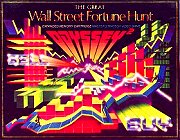 The Game: Feel like literally “playing” the stock market? This game allows you to do so with varying degrees of accuracy, ranging from level one – simple trading – to level four, which allows buying on margins, prime rate interest calculations, and numerous other complications. A ticker across the top of the screen gives the current values of several stocks and commodities, while a ticker running across the center of the screen gives the latest news updates. The nature of that news can have drastic effects on the stocks available for trade, ranging from the sometimes silly (“electronic foot massager increases worker productivity”) to the frighteningly prophetic (“war threat in the Middle East”). (North American Phillips, 1983)
The Game: Feel like literally “playing” the stock market? This game allows you to do so with varying degrees of accuracy, ranging from level one – simple trading – to level four, which allows buying on margins, prime rate interest calculations, and numerous other complications. A ticker across the top of the screen gives the current values of several stocks and commodities, while a ticker running across the center of the screen gives the latest news updates. The nature of that news can have drastic effects on the stocks available for trade, ranging from the sometimes silly (“electronic foot massager increases worker productivity”) to the frighteningly prophetic (“war threat in the Middle East”). (North American Phillips, 1983)
Memories: An interesting idea for a console game (whereas this sort of thing would usually be found only on computers, especially back then), The Great Wall Street Fortune Hunt was the third and final Master Strategy Series game released for the Odyssey2.
Gorf
 The Game: As the pilot of a solo space fighter, you take on several different varieties of alien attacks masterminded by those pesky, ever-present Gorfian robots. (Coleco, 1983)
The Game: As the pilot of a solo space fighter, you take on several different varieties of alien attacks masterminded by those pesky, ever-present Gorfian robots. (Coleco, 1983)
Memories: As often is the case with ColecoVision games, this version of the classic Bally/Midway arcade game is visually and aurally faithful to its inspiration, but two key elements didn’t make it into this home version of Gorf: the speech synthesis and the “Galaxians” stage, the latter of which may have vanished to ensure that Bally/Midway could spread around the license for Gorf‘s predecessor, Galaxian, among as many companies as possible, maximizing profits. (The “Galaxians” stage was also missing from CBS/Fox’s Atari 2600 version of Gorf, as Atari had already snagged the cartridge rights to Galaxian for itself.)
Frogger
 The Game: In a faithful home version of Sega’s original arcade game, you’re a frog trying to cross a highway, and then safely hop across the backs of logs and turtles – while avoiding alligators, snakes and otters – all to get home at the top of the screen. (Parker Brothers, 1983)
The Game: In a faithful home version of Sega’s original arcade game, you’re a frog trying to cross a highway, and then safely hop across the backs of logs and turtles – while avoiding alligators, snakes and otters – all to get home at the top of the screen. (Parker Brothers, 1983)
Memories: I’ve had the Atari 2600 version of Frogger for a long time, and I’ll admit that both the MAME version of the original arcade game and the Coleco tabletop battery-powered electronic Frogger have always struck me as being very faithful. But as far as early 80s platforms go, ColecoVision wound up with the most faithful Frogger of all.
Flipper Slipper
 The Game: The water is rising! You’re all that stands between the animals and rising floodwaters. Using a pair of paddles, you have to keep a projectile moving without letting it knock a hole in the seawall behind you; if too many holes are blasted through the wall, the game will be over and the water will pour in. (Spectravideo, 1983)
The Game: The water is rising! You’re all that stands between the animals and rising floodwaters. Using a pair of paddles, you have to keep a projectile moving without letting it knock a hole in the seawall behind you; if too many holes are blasted through the wall, the game will be over and the water will pour in. (Spectravideo, 1983)
Memories: Of all the places to find an oldie-but-goodie game concept. Flipper Slipper is a game that plays very similar to Cutie Q – i.e., the last game designed by Toru Iwitani before he created Pac-Man for Namco.
Fantastic Voyage
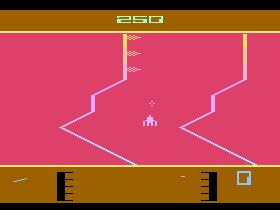 The Game: Man a biological “spaceship” and get ready to shrink down to microscopic size – you’re going on a voyage through the human body! Blasting away viruses and disease cells, and leaving the body’s natural defenses intact, you’re going to give the immune system a little bit of a boost – at least until a disease cell takes out your micro-ship. Based on the 1966 movie of the same name. Raquel Welch not included. (20th Century Fox Video Games, 1983)
The Game: Man a biological “spaceship” and get ready to shrink down to microscopic size – you’re going on a voyage through the human body! Blasting away viruses and disease cells, and leaving the body’s natural defenses intact, you’re going to give the immune system a little bit of a boost – at least until a disease cell takes out your micro-ship. Based on the 1966 movie of the same name. Raquel Welch not included. (20th Century Fox Video Games, 1983)
Memories: It’s a Vanguard clone. That’s really always been my first reaction to the very sight of Fantastic Voyage. Now, it’s not a bad idea for a game, nor is it even a bad license, but…it’s a Vanguard clone. And in any event, the save-the-patient-from-disease genre already had an all-time winner at the top of its list: Imagic’s Microsurgeon for the Intellivision. Now, to be fair, versions of that game were announced, but never released, for other platforms (with the exception of a rare version for the TI 99/4A computer) – this genre wasn’t exactly tapped out on the 2600. But I would’ve hoped for something more than a Vanguard clone.
Enduro
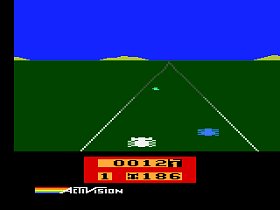
 The Game: As one of many drivers in a round-the-clock endurance race through many areas, terrains and weather conditions. While the pretty boys at Fuji may have sunshine all the time (or so it seems), an Enduro racer has to contend with slick snow, nighttime driving conditions (where the other drivers’ tail lights are the only warning you have of their presence), fog (which is much like night driving, but about 10 times worse), and so on. (Activision, 1983)
The Game: As one of many drivers in a round-the-clock endurance race through many areas, terrains and weather conditions. While the pretty boys at Fuji may have sunshine all the time (or so it seems), an Enduro racer has to contend with slick snow, nighttime driving conditions (where the other drivers’ tail lights are the only warning you have of their presence), fog (which is much like night driving, but about 10 times worse), and so on. (Activision, 1983)
Memories: Enduro is a killer driving game, taking the same graphical gimmick that made Pole Position a hit, and increasing the challenge of the game – even to the point of exceeding the depth of the game that it’s loosely based on.
Donkey Kong Jr.
 The Game: As the offspring of the mighty monkey, it’s up to you to scale vines and chains, avoid mobile traps, occasionally grab some yummy fruit (since when is a little ape on Pac-Man’s diet?), and get to the key or keys that will free your papa. (Coleco, 1983)
The Game: As the offspring of the mighty monkey, it’s up to you to scale vines and chains, avoid mobile traps, occasionally grab some yummy fruit (since when is a little ape on Pac-Man’s diet?), and get to the key or keys that will free your papa. (Coleco, 1983)
Memories: Again very faithful to its arcade namesake, the Coleco version of Donkey Kong Jr. is an essential addition to the ColecoVision player’s library, with very accurately reproduced sound and graphics.
Crackpots!
 The Game: You are Potsy, a flowerpot-chucking tenant in a building being overrun by spiders. As they come up the walls, hurl potted plants at ’em to squish them before they can climb into the windows; if too many spiders make it
The Game: You are Potsy, a flowerpot-chucking tenant in a building being overrun by spiders. As they come up the walls, hurl potted plants at ’em to squish them before they can climb into the windows; if too many spiders make it  through, they eat away at the building from the ground up until game is over. Black spiders follow a straightforward, no-nonsense path to the windows, while blue spiders zig-zag a bit. Red and green spiders follow more unpredictable paths, forcing you to try to nail them as they crawl the walls diagonally. Super powers will not be granted to you if you get bitten. (Activision, 1983)
through, they eat away at the building from the ground up until game is over. Black spiders follow a straightforward, no-nonsense path to the windows, while blue spiders zig-zag a bit. Red and green spiders follow more unpredictable paths, forcing you to try to nail them as they crawl the walls diagonally. Super powers will not be granted to you if you get bitten. (Activision, 1983)
Memories: Sort of like a slide-and-shoot game in reverse, Crackpots! is a fun little number with some cute graphics and game play speed that gradually (but inevtiably) goes off the scale. Still, it’s incredibly simple and loads of fun too – and not surprisingly, it’s been revived for more modern consoles as part of Activision’s classic game compilations.
Boing!
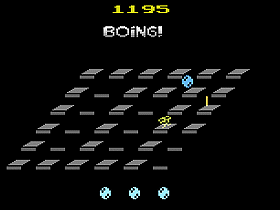 The Game: You’re a bubble bounding around a series of platforms, changing the color of every segment on which you land. Your job is to change the color of the entire playing field while avoiding everything else, including an equally mobile needle that has a point to make. If you run into your adversaries too many times, I hate to burst your bubble, but the game’s over. (First Star Software. 1983)
The Game: You’re a bubble bounding around a series of platforms, changing the color of every segment on which you land. Your job is to change the color of the entire playing field while avoiding everything else, including an equally mobile needle that has a point to make. If you run into your adversaries too many times, I hate to burst your bubble, but the game’s over. (First Star Software. 1983)
Memories: One of the earliest entries into the video game arena by First Star Software – an outfit which is actually still in business, unlike a lot of other latecomers to the ’80s video game race – Boing! is obviously another take on the basic game play concepts of Q*Bert, and truth be told, it doesn’t bring any new innovations to the table, but it’s a slight improvement audiovisually. Boing! can also boast an easier control scheme, since it doesn’t ask the player to rotate the joystick 45 degrees. That’s a big help.
Blue Print
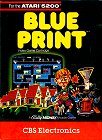 The Game: You are the intrepid, barbershop-quartet-suited J.J. (hey, it’s better than being O.J.!), out to save a damsel in distress from a pursuing monster. How does a guy in a little striped suit do this? By building a mobile, tennis-ball-launching contraption to dispatch said dastardly monster, naturally. The catch? The eight pieces of your mechanical creation are hidden somewhere among ten little houses in a maze – and those houses that don’t contain parts of your machine contain a bomb that must be dumped into the bomb pit immediately (else they’ll explode and kill J.J.). Critters also roam the maze to annoy you, including one pesky monster who will prematurely jump on the “start” button, rattling your still-unfinished machine to bits. If you don’t build your Rube Goldberg gizmo in time, the monster catches the damsel and you lose a life. (CBS Electronics, 1983)
The Game: You are the intrepid, barbershop-quartet-suited J.J. (hey, it’s better than being O.J.!), out to save a damsel in distress from a pursuing monster. How does a guy in a little striped suit do this? By building a mobile, tennis-ball-launching contraption to dispatch said dastardly monster, naturally. The catch? The eight pieces of your mechanical creation are hidden somewhere among ten little houses in a maze – and those houses that don’t contain parts of your machine contain a bomb that must be dumped into the bomb pit immediately (else they’ll explode and kill J.J.). Critters also roam the maze to annoy you, including one pesky monster who will prematurely jump on the “start” button, rattling your still-unfinished machine to bits. If you don’t build your Rube Goldberg gizmo in time, the monster catches the damsel and you lose a life. (CBS Electronics, 1983)
Memories: One of my favorite genre-crossing arcade titles, Blue Print was one of several in-house gems from Bally/Midway which were licensed under an overall deal with CBS Electronics. And while I mourn the fact that they never got around to making Kickman for the 5200, I can take come comfort in the work of art that is CBS’ home version of Blue Print.